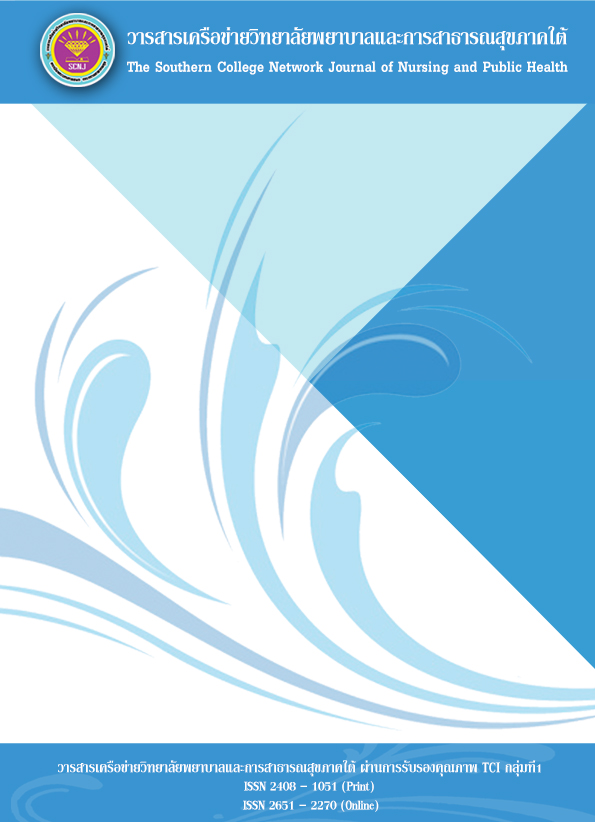การพัฒนาองค์กรรอบรู้ด้านสุขภาพในคลินิกฝากครรภ์: ผลดีที่เกิดขึ้นและการสื่อสารเพื่อส่งเสริมความรอบรู้ทางสุขภาพ
คำสำคัญ:
ผลลัพธ์ของการตั้งครรภ์, ภาวะซีดในหญิงตั้งครรภ์, การเพิ่มขึ้นของน้ำหนักในหญิงตั้งครรภ์, องค์กรรอบรู้ด้านสุขภาพ, การวิจัยเชิงปฏิบัติการบทคัดย่อ
การวิจัยเชิงปฏิบัติการนี้มีวัตถุประสงค์ คือ 1) เพื่ออธิบายการพัฒนาองค์กรความรอบรู้ด้านสุขภาพของคลินิกฝากครรภ์ 2) ศึกษาผลลัพธ์ของการพัฒนา และ 3) เพื่อสรุปเทคนิคการสื่อสารที่มีประสิทธิภาพ อุปสรรคการให้บริการ และข้อเสนอแนะเพื่อการพัฒนา โดยศึกษาจากคลินิกฝากครรภ์ 11 แห่งของโรงพยาบาลในจังหวัดสระบุรี การพัฒนามี 4 ขั้นตอนคือ 1) กำหนดนโยบายโดยผู้นำองค์กร และประสานองค์กรสนับสนุนงบประมาณ 2) พัฒนาหลักสูตรและฝึกอบรมบุคลากรสุขภาพ 3) สนับสนุนงบประมาณ และกำกับติดตาม และ 4) ประเมินผลลัพธ์การดำเนินการ ได้แก่ 1) การเพิ่มของความเข้มข้นเลือด (Hematocrit) ของหญิงฝากครรภ์ครั้งแรก 28 คนที่มี Hematocrit ต่ำกว่า 33 % และติดตามการเพิ่มขึ้นเมื่ออายุครรภ์ 32 สัปดาห์ 2) ติดตามการเพิ่มขึ้นของน้ำหนักหญิงตั้งครรภ์ 154 คน จากอายุครรภ์ 20 สัปดาห์ ถึง 34 สัปดาห์ และ 3) สรุปเทคนิคการสื่อสารเพื่อส่งเสริมความรอบรู้ทางสุขภาพสำหรับหญิงตั้งครรภ์ เก็บข้อมูลจากการสนทนากลุ่มกับพยาบาลวิชาชีพ 10 คน สัมภาษณ์เชิงลึก 2 คน วิเคราะห์ข้อมูลเชิงปริมาณด้วยสถิติความถี่ และร้อยละ และข้อมูลเชิงคุณภาพใช้วิธีการวิเคราะห์เนื้อหา ผลการวิจัยพบว่า
1. หญิงตั้งครรภ์ 28 คน Hematocrit เพิ่มขึ้น (≥ 33 %) 57.1 % 2) หญิงตั้งครรภ์ 154 คน ประกอบด้วยกลุ่ม น้ำหนักต่ำหว่าเกณฑ์ 30 คน น้ำหนักปกติ 81 คน น้ำหนักเกินเกณฑ์ 27 คน และอ้วน 16 คน ผลพบว่ากลุ่มน้ำหนักต่ำกว่าเกณฑ์ และน้ำหนักปกติมีมีน้ำหนักขึ้นตามเกณฑ์ 60 % และ 34.6% ตามลำดับ ส่วนกลุ่มน้ำหนักเกินเกณฑ์ และอ้วน มีน้ำหนักเพิ่มเกินเกณฑ์ทั้ง 2 กลุ่ม และ 3) เทคนิคการสื่อสาร ได้แก่ 1) ค้นหาปัญหาสุขภาพ 2) ขอข้อมูลเพิ่ม 3) สร้างการมีส่วนร่วม และเลือกวิธีการจัดการสุขภาพตามศักยภาพของหญิงตั้งครรภ์ 4) แนะนำ เว็บไซต์ที่มีประโยชน์ และ 5) กำหนดเป้าหมายทางสุขภาพเมื่อมาตรวจครั้งต่อไป อุปสรรคการให้บริการคือ ใช้เวลาบริการมากเกินไป
สถานบริการที่ให้บริการฝากครรภ์ สามารถนำเทคนิคการสื่อสารที่พบจากการศึกษานี้ไปใช้ในการให้บริการสุขภาพประชาชนกลุ่มที่มีความรอบรู้ทางสุขภาพต่ำได้
เอกสารอ้างอิง
Bjørk, I. D., Lomborg, K., Nielsen, C. M., Brynildsen, G., Frederiksen, A. S., Larsen, K., et al. (2013). From Theoretical Model to Practical Use: an Example of Knowledge Translation. Journal of Advanced Nursing, 69(10), 1-11.
Brach, C. (2017). The Journal to Become a Health Literate Organization: A Snapshot of Health System Improvement. Studies in Health Technology and Informatics, 240, 203-237.
Bradley, E. H., Curry, L. A., Ramanadhan, S., Rowe, L., Nembhard, I. M., & Krumholz, H. M. (2009). Research in Action: Using Positive Deviance to Improve Quality of Health Care. Implementation Science. Retrieved January 22, 2018 from https://doi.org/10.1186/ 1748-5908-4-25
Burgess, J. (2006). Participation Action Research: First-Person Perspectives of a Graduate Student. Action Research, 4(4), 419-437.
Champlin, S., Walker, L. O., & Mackert, M. (2016). Gestational Weight Gain Through a Health Literacy Lens: A Scoping Review. The Journal of Perinatal Education, 25(4), 242-256.
Daru, J., Zamora, J., Fernández-Félix, B. M., Vogel, J., Oladapo, O. T., & Morisaki, N., et al. (2018). Risk of Maternal Mortality in Women with Severe Anaemia During Pregnancy and Post Partum: A Multilevel Analysis. Lancet Glob Health. Retrieved January 22, 2018 from https://doi.org/10.1016/S2214-109X(18)30078-0.
Habermas, J. (1981). The Theory of Communicative Action, Volume 1: Reason and the Rationalization of Society. (Translate by Thomas McCarthy). London: Heinemann Educational Books Ltd.
Institute for Healthcare Improvement. (2018). Ask Me 3: Good Questions for Your Good Health. Retrieved January 22, 2018 from http://www.ihi.org/resources/Pages/Tools/Ask-Me-3-Good-Questions-for-Your-Good-Health.aspx
Kemmis, S., & McTaggart, R. (2005). Participatory Action Research: Communicative Action and the Public Sphere. In Handbook of Qualitative Research. 3rd (Edit by Denzin, N. K. & Lincoln, Y S. London: Sage Publications.
Koh, H. K., Brach, C., Harris, L. M., & Parchman, M. L. (2013). A Proposed “Health Literate Care Model” Would Constitute: A System Approach to Improving Patients’ Engagement in Care. Health Aff (Milwoof), 32(2), 357-367.
MacDonald, C. (2012). Understanding Participatory Action Research: A Qualitative Research Methodology Option. Canadian Journal of Action Research, 13(2), 34-50.
Ministry of Public Health. (2017). Health Data Center: Maternal and Child Health Report. Retrieved January 22, 2018 from https://hdcservice.moph.go.th/hdc/main/index_pk.php
Montgomery, A., Doulougeri, K., & Panagopoulou, E. (2015). Implementing Action Research in Hospital Settings: a Systematic Review. Journal of Health Organization and Management, 29(6), 729-749.
Neuhauser, L. (20.7). Integrating Participatory Design and Health Literacy to Improve Research and Interventions. Information Services & Use. Retrieved January 22, 2018 from DOI 10.3233/ISU-170829
Nilses, C., Persson, M., Lindkvist, M, Petersson, K., & Mogren, I. (2017). High Weight Gainduring Pregnancy Increases the Risk for Emergency Caesarean Section-Population-Based Data from the Swedish Maternal Health Care Register 2011-2012. Sexual & Reproductive Healthcare, 11, 47-52.
Panda, B. K., Taralekar, V. S., Mishra, A., & Srivastava, P. (2015). Anemia in Pregnancy: Improving Adherence with Intervention. Biopharm Journal, 1(1), 33-40.
Penti, B. (2015). Assessing Health Literacy and Perception Healthcare (PCH) Risk among Black/African-American Women Via Web-Based Conversation Agent Technology. 7th Annual Health Literacy Research Conference (HARC) November 2-3, 2015, Bethesda. Retrieved January 22, 2018 from https://www.bumc.bu.edu/healthliteracyconference/ files/2015/09/Penti-Health-Literacy-Gabby-10-11-2015.pdf
Pipatkul, W., Sinsuksai, N., & Phahuwatanakorn, W. (2015). Effects of a Nutrition and Iron Supplement Promoting Program on Iron Deficiency Anemia in Pregnancy Women. Journal of Nursing Science, 33(1), 69-76.
Rasmussen, K. M., Abrams, B. Bodnar, L. M., Butte, N. F., Catalano, P. M., & Siega-Riz, A. M. (2010). Recommendations for Weight Gain During Pregnancy in the Context of Obesity Epidermic. Obstetric Gynecology, 116(5), 1191-1195.
Roma, W. (2018). Guideline for Development to Health Literate Organization of National Institute of Child Health. Retrieved January 22, 2018 from http://dohhl.anamai.moph.go.th/ewt_dl_link.php?nid=11 (in Thai)
Singer, S. J. (2013). The Time is Now for Action Research. Israel Journal of Health Policy Research Israel Journal of Health Policy Research Retrieved January 22, 2018 fromhttps://doi.org/10.1186/2045-4015-2-41
Suwannaka, Y., Sosome, B., & Chaowaing, K. (2016). The Developmental Model for Enhancing Cultural Competences of Nurse Instructors and Bachelor Nursing Students. Journal of Nursing and Health Care, 34(4), 162-171.
Thitpad, C., & Banchonhattakit, P. (2012). Effects of Eating Behavior Program for Pregnant Women with Weight Gain During Pregnancy in ANC Clinic, Tertiary Hospital, Khon Kaen Province Srinagarind Medical Journal, 27(4), 347-353.
World Health Organization. (2018). Daily Iron and Folic Acid Supplementation During Pregnancy. Retrieved January 22, 2018 from https://www.who.int/elena/titles/daily_ iron_pregnancy/en/
ดาวน์โหลด
เผยแพร่แล้ว
ฉบับ
ประเภทบทความ
สัญญาอนุญาต
1. บทความหรือข้อคิดเห็นใด ๆ ที่ปรากฏในวารสารเครือข่าย วิทยาลัยพยาบาลและการสาธารณสุขภาคใต้ ที่เป็นวรรณกรรมของผู้เขียน บรรณาธิการหรือเครือข่ายวิทยาลัยพยาบาลและวิทยาลัยการสาธารณสุขภาคใต้ ไม่จำเป็นต้องเห็นด้วย
2. บทความที่ได้รับการตีพิมพ์ถือเป็นลิขสิทธิ์ของ วารสารเครือข่ายวิทยาลัยพยาบาลและการสาธารณสุขภาคใต้








